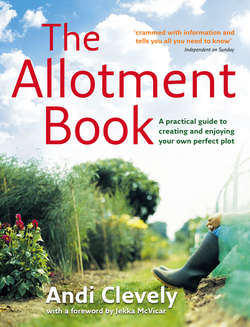Читать книгу The Allotment Book - Andi Clevely - Страница 20
crop rotation
ОглавлениеWhat is crop rotation? This is the custom of moving annual and biennial vegetables year by year around a number of different beds. A key technique in traditional husbandry, and equally important as part of efficient organic gardening, crop rotation ensures the same type of plant is not grown in successive years in the same piece of ground. Crops with similar needs and susceptibilities are grouped together, each group moving on to the next bed in the rotation the following year. Thus a crop literally rotates around the arrangement of beds until it returns to the first bed in the sequence a number of years later (see pages 32–5).
Rotation helps to avoid disorders by interrupting the life cycles of pests and diseases. It can also prevent the gradual depletion of certain soil nutrients. The principle is a sound insurance against inviting unnecessary problems, even in its simplest form of growing crops wherever you like but making sure no group or individual vegetable occupies the same spot in two consecutive years (with the exception of perennials, see page 31). Just moving a crop a few metres is a worthwhile precaution, but this minimalist approach requires a good memory and efficient organization. Following a full crop rotation scheme is usually more dependable.
A simple, efficient way to organize crops is to divide them into the three main traditional groups of root crops, brassicas and legumes, and base the rotation on these. The advantage of this approach is that members of each group need similar soil preparation, so the whole bed can be cultivated accordingly. Vegetables like salad greens, tomatoes and squashes, which do not obviously belong in any of these categories, are fitted in wherever there is space; perennial crops are, of course, not rotated.
VARIATIONS With three vegetable groups and three beds to rotate them in annually, each group will get back to where it started in the fourth year, so this standard system is called a four-year (‘course’ or ‘stage’) rotation. It is not inflexible: you can extend the number of years before a group returns to its original position by adding extra courses; some gardeners give maincrop onions a bed to themselves, grow potatoes as a separate course from other roots, or allow one or more fallow years for green manure crops.
Nor is the system infallible. Some vegetables, especially winter crops, overlap inconveniently with others. Some pathogens survive in the soil for many years, so you still need to be alert for symptoms of disorders. Opinions differ about whether it is better to isolate crops with common serious disorders – separating potatoes and tomatoes to prevent the spread of blight – or grow them together to keep the problem in one place, where it is more manageable. Experience will determine your own preferred approach.
